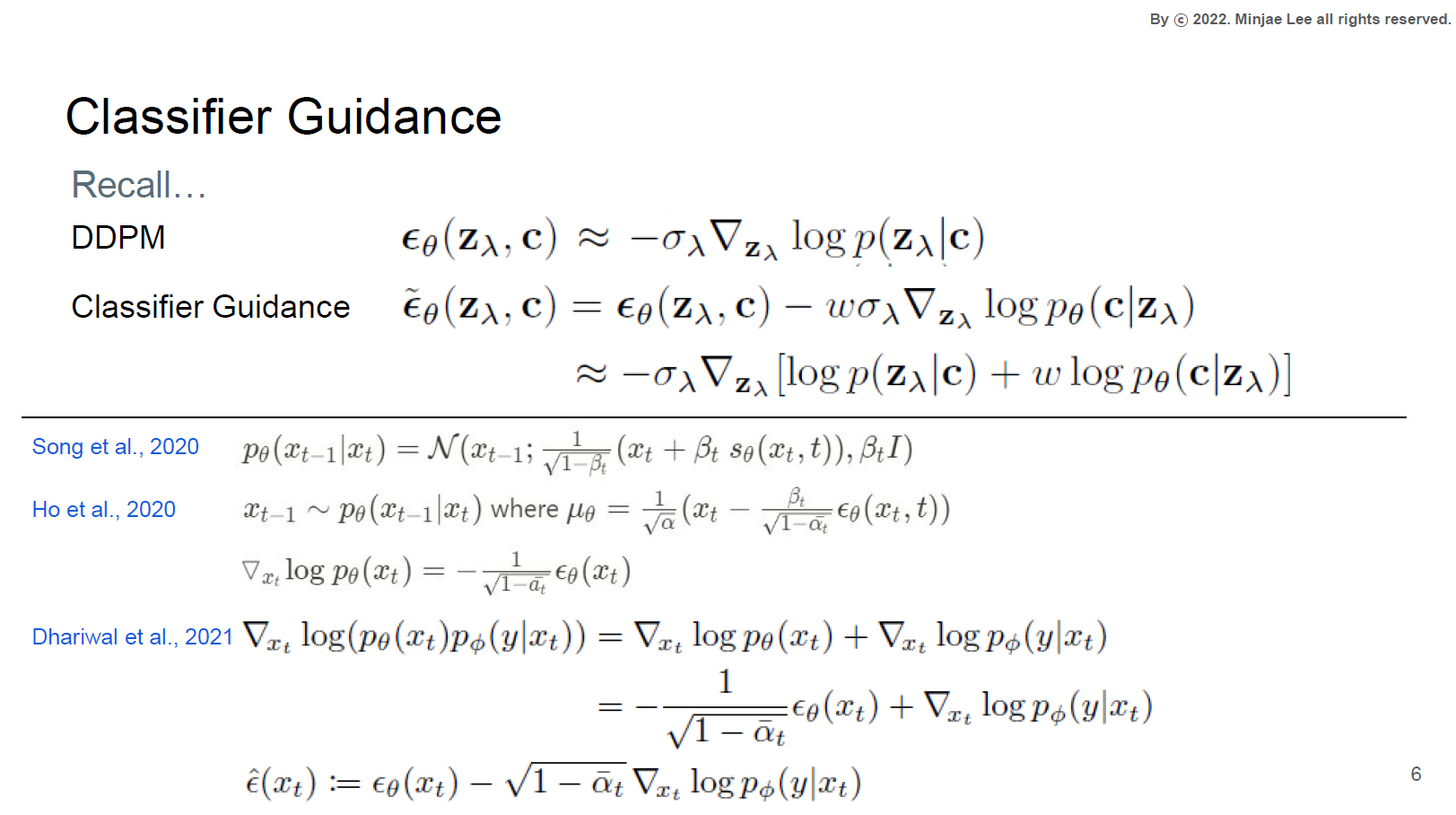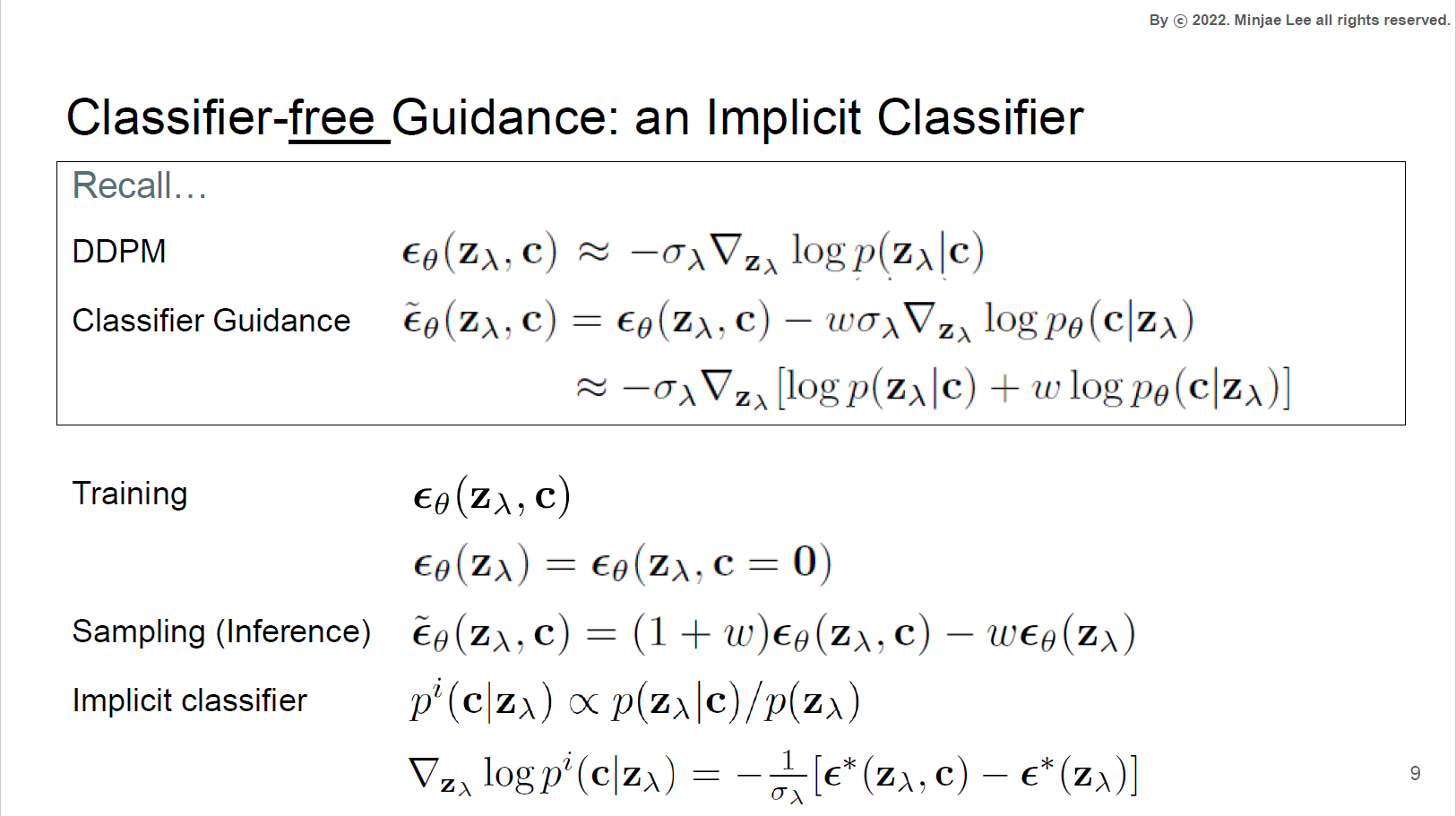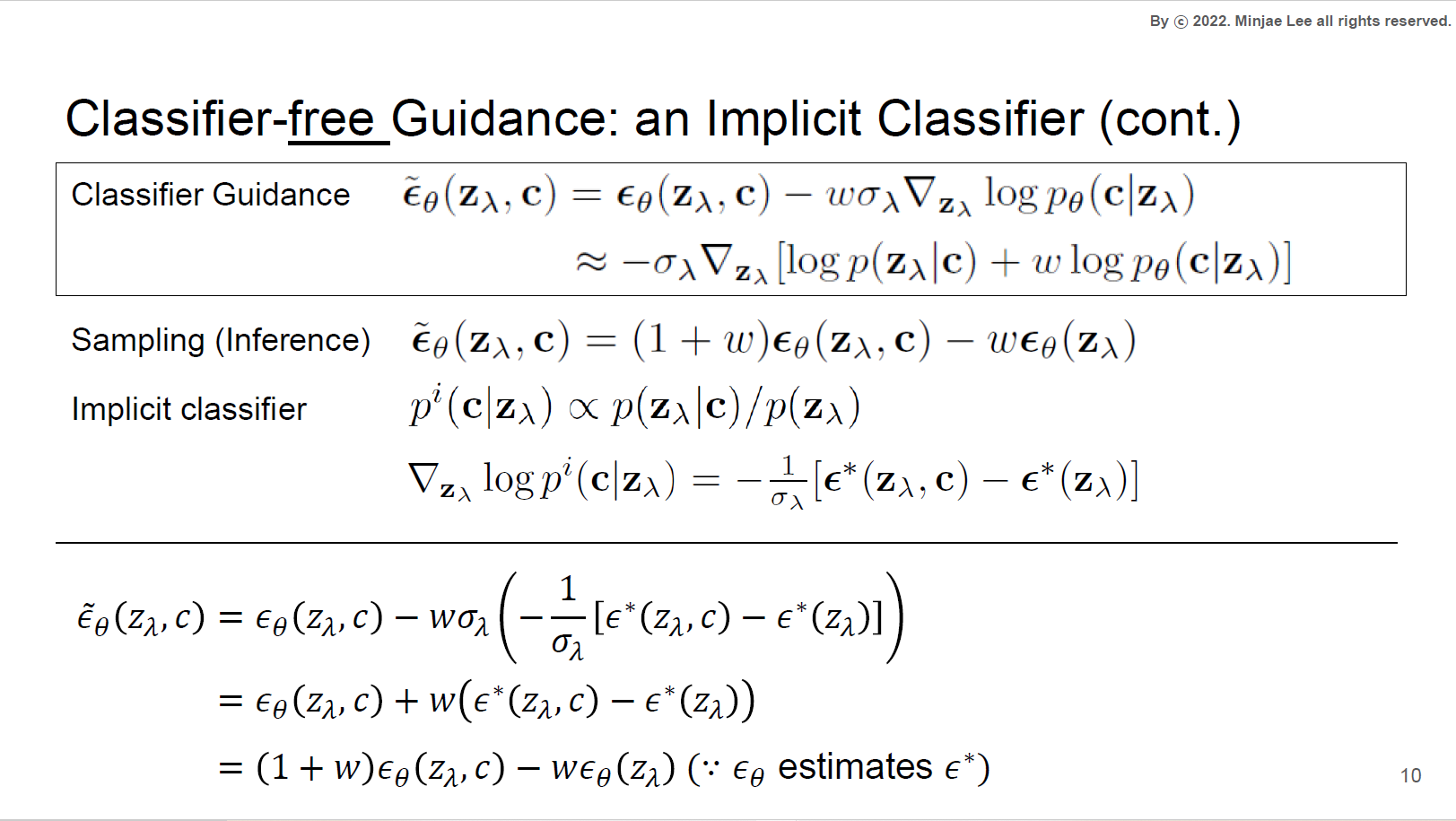Intro
gradient를 이용한 guidance나 truncation trick에 익숙하면 논문의 취지를 쉽게 파악할 수 있다.
One-sentence Summary
- kor: Diffusion Models Beat GANs on Image Synthesis에서 수행한 classifier-guidance를 pre-trained classifier 없이도 (classifier-free) 수행할 수 있음을 보인 논문
- en: Introducing classifier-free guidance performing classifier-guidance without the pre-trained classifier, necessitated in previous paper ‘Diffusion Models Beat GANs on Image Synthesis’
- A link for the paper: https://openreview.net/forum?id=qw8AKxfYbI
- The PPT file I made for the review: 220516classifier_free_guidance mj.pdf
Classifier Guidance
Diffusion Models Beat GANs on Image Synthesis (Dhariwalet al., 2021)
Classifier-Free Guidance가 있으면, 그냥 Guidance도 있지 않을까?
그걸 다룬 것이 Dhariwalet al., 2021 논문이다.
classifier-guidance를 통해 fidelity와 diversity를 trade-off 시킬 수 있고, 그렇게 하면 fidelity 측면에서 diffusion model이 GAN 모델 중 SOTA인 BigGAN을 이긴다는 내용이다.Diffusion model과 score-based model의 관계
DDPM (Denoising Diffusion Probabilistic Models) 논문의 의의는 근본 diffusion model을 제시한 것에 그치지 않는다.
diffusion model과 score-based model의 내재적 연결성을 밝힌 것이 또다른 중요한 의의이다.
다시말해, 원본 데이터와 timestep, epsilon을 샘플링해서 ($X_0\sim D$, timestep $t\sim T$, $\epsilon \sim N$ $X_t$를 만들고 그것으로 $\hat{\epsilon} (X_t, t)$를 output했을 때, 그 output $\hat{\epsilon}$ 가 score-function, 즉 gradients of log probability density functions이라는 것이다.

- 그 관계가 왜 중요한가?
이 점을 알고나면, classifier-guidance에서 왜 난데없이 diffusion model output $\hat{\epsilon}$ ${(z_{\lambda},c)}$에 score-function인 $\nabla_{z_{\lambda}} \log p_{\theta} (c|z_{\lambda})$ 를 더해버리는지 알 수 있다.
위에서 언급한 관계에 의하면 사실 둘은 같은 개념이기 때문에 weighted sum (by $w$) 할 수 있었던 것이다!
따라서 위 식의 흐름을 말로 풀어보면, 원래 diffusion model로 생성한 vector field에 classifier로 만든 vector field를 더해주어 원하는 class로 guide할 수 있고, 그 guide하는 정도는 weight $w$에 의해 조절된다고 할 수 있다.
Classifier-‘Free’ Guidance
- Classifier-‘Free’ Guidance의 필요성
그럼 왜 Classifier-‘free’ Guidance가 필요할까?
classifier-guidance는 noised data로 학습한 pre-trained classfier가 필요한데, 이게 data pipeline을 복잡하게 만든다.
또 (저자들의 주장에 따르면) noised data를 사용한 것이 adversarial attack을 일으켜 성능 저하를 일으킨다.
그래서 이 논문은 classifier 없이 순수하게 generative model만 이용해서 guidance를 주는 방법을 택했다.
물론 그 대가로 sampling speed가 느려질 수 있는데, 보통 classifier보다 generative model이 크기 때문에 forward가 느려서 그렇다.


Training & Inference in Classifier-Free Guidance
한 diffusion model을 (DDPM처럼 backbone은 U-net)을 train할 때
– class-conditional은 특정 class로 condition을 준 후 학습하고
– class-unconditional은 class를 random으로 섞어서 학습하고
학습 후 inference할 때, conditional과 unconnditional의 output $\hat{\epsilon}$ ${(z_{\lambda},c)}$, $\hat{\epsilon}$ ${(z_{\lambda})}$ 을 weighted sum 한다!Classifier-Free Guidance 식으로 이해하기
식이 보여주는 큰 흐름을 먼저 짚자면, 기존 classifier guidance식의 guidance term을 pre-trained classifier 없이 generative model의 output $\epsilon$만으로 나타낼 수 있다는 것이다.
– implicit classifier: classifier가 별도로 있는 것은 아니지만, 개념적으로 implicit한 classifier를 생각해보면 bayes rule을 이용해서 score function을 구할 수 있다. 거기에 DDPM에서 밝힌 내재적 연관성을 얹으면 implicit classifier로부터 구한 score function은 conditional과 unconditinal model의 output $\epsilon_{\theta} (z_{\lambda}, c)$ 와 $\epsilon_{\theta} (z_{\lambda})$ 으로 표현된다.
– Classifier-Free guidance: 그럼 implicit classifier의 score function을 classifier guidance의 score function 식에 그대로 대입하면 $\tilde\epsilon_{\theta} (z_{\lambda}, c)$ 는 $\epsilon_{\theta} (z_{\lambda}, c)$ 와 $\epsilon_{\theta} (z_{\lambda})$ 의 Linear combination, 즉 conditional과 unconditional model outputs를 Linear combination한 값이 된다. 그렇기에 학습해둔 model에서 sampling (inference) 할 때도 condition을 줘서 한번, condition 주지 않고 한번 output을 뽑아서 linear combination하는 것이다.
이때 cond 와 uncond의 차이를 $w$로 scaling해주기 떄문에 weight $w$를 세게 주면 class 정보가 더 세게, 즉 condition과 uncondition의 차이가 강조되는 것으로 해석할 수 있다. 이는 곧 guidance를 세게 주는 것과 마찬가지이다.sidenote: $\epsilon$ 에 별을 붙여서 $\epsilon^*$로 나타낸 이유?
논문에 ‘If we had access to exact scores …‘라는 표현이 나온다.
Discussion 파트에 보면, ‘Our diffusion models are parameterized by unconstrained neural networks and therefore their score estimates do not necessarily form conservative vector fields, unlike classifier gradients’라는 구절이 나온다.
뭔 소린지는 좀더 봐야 제대로 이해할 것 같지만… conservative vector field가 있어야만 classifier log likelihood 같은 scalar potential이 존재한다는 것을 보장할 수 있나보다.
classifier-guidance에서는 diffusion model과 완전히 분리된 pre-trained classifier의 gradient를 쓴다.
그런데 classifier-free guidance에서는 unconstrained neural net을 썼기 때문에, model의 output인 score estimates가 non-conservative한 vector field이다.
따라서 보통 classifier log likelihood 같은 scalar potential이 존재하지 않는다.
이는 곧 위에서 언급한 $\epsilon_{\theta} (z_{\lambda}, c)$ 와 $\epsilon_{\theta} (z_{\lambda})$의 Linear combination을 classifier guided score로 가지는 classifier가 보통 존재하지 않는다는 소리이다.
이론적으로는 그렇지만, 경험적으로 봤을 때는 implicit classifier 가정이 잘 먹히고 실험적으로도 증명되었기 때문에, 이론적 불완전성을 커버할 수 있다고 생각한 것 같다…(공부 더 필요.. 또르르)sidenote: 모든 image의 평균 image는 무엇인가? 이건 겻님이 질문했던 내용이다.
unconditional로 학습할 때는 class들을 random으로 섞어서 학습한다.
그렇게 학습한 모델의 아웃풋은 모든 image의 평균 image일 텐데 그게 어떻게 생겼을까?라는 게 질문의 요지였다.
사실상 classifier-free guidance는 특정 class의 image에서 평균 image를 빼는 방식으로 guidance를 주는 것이다. 답은 output을 직접 뽑아봐야 알겠지만, 이런 식으로 생각해본 적이 없어서 흥미로운 질문이었다,,
